Herculaneum, Campania, Italy, 1/2014
While nearly everyone has heard of the horrible tragedy of Pompeii, (If you haven’t, read our last blog.), several people had told us that the town of Herculaneum on the coast was equally astounding. Comparatively small with a population of approximately 4000, Herculaneum covered an area of about 50 acres of which only 11 have been excavated. The modern town Ercolano sits on top of it.
As Vesuvius erupted in 79 AD, Herculaneum was covered by flows of pyroclastic rock that solidified to an average height of approximately 16 meters, (53 feet). This tragic event created a phenomenal preservation that is absolutely original, nothing at all like Pompeii. Archaeological finds have included plants, fabrics and furniture, structural parts of wooden buildings and even a boat & a fisherman’s basket were recovered from the ancient Marina.
One of the most shocking areas was a line of vaulted rooms used as port warehouses and boat storage opened to the beach. In 1982, over 300 human skeletons were found along with valuables they carried with them as they sought safe refuge at the water’s edge. They were killed almost instantly by the 500°F heat wave and the blazing clouds of exploding gas from the volcano. The vantage point from a walkway over 3 stories above the area that used to be the beach, showed a graphic example of the astounding amount of ash and rock that covered this fishing village.
Wandering through the cobblestone streets we explored the luxurious vaulted Central Steam Baths for both men and women, with cold rooms and dressing rooms. Beautiful homes retained their intricate mosaic floors and well preserved frescoes on the walls. At times it felt like we should knock on someone’s door before entering or that the whole village was just gone for the day. There was a bakery with its interesting millstones and a fast food thermopolium like we had seen in Pompeii.
We even found a laundromat, well, sort of. According to historical documents, clothes were washed in troughs filled with water & soda, and barefoot men were stomping them. Then they were soaked in human or animal urine to bleach them. After they were rubbed with clay to soften them, they were rinsed and hung to dry. Next they were brushed to make them shiny and later put in a wooden crate or cage where sulfur was burnt underneath to make them smell good, (a relative term after being soaked in urine). Finally they were neatly folded and pressed in a device we thought at first was an olive or wine press, but in fact, it was made for clothes. Amazingly, this laundry press survived the disaster and is the only one of its kind preserved to this day.
Excavations at Herculaneum are ongoing with tunnels being bored into cliffs of ash. What was once a beautiful beach is gone. Vesuvius added a strip of land to the oceanfront some 400 meters wide, (1312 feet).
- Wandering through the cobblestone streets many of the two-story homes were still intact. Amazing when you realize that they had been completely buried in ash and rock for centuries before excavation began.
- To our amazement, in this entry hall of a beautiful home we discovered not only well preserved frescoes and a fountain but also a slideable wooden (!) wall to separate the public from the private areas.
- Charred wooden beams had survived, testimony to the sheer wave of heat that exploded over the city.
- The women’s vaulted suburban steam bath with a cold room and dressing had survived the disaster.
- The black mosaic floor on a white background of the women’s bath looked like it might have been used yesterday.
- Intricate mosaic floors and beautiful frescoes on the walls displayed the high standard of living in Herculaneum.
- We had seen these fast food thermopolia in Pompeii. Double Cheese Mac with fries please.
- Senator M. Nonius Balbus thought so much of himself, he had several busts and statues done, this one in full armor.
- Water was piped underground for fountains like this one.
- The grinding mills see here seemed to be the standard of that era.
- The final step, washed and dried and sulfured clothes were folded and pressed here.
- Gary ponders the height of the wall of ash and rock yet to be excavated.
- The grassy area was the beach in front of the boat storage rooms (on the left) where hundreds died.
- This well-preserved boat and remnants of fishing nets, hooks and even a fishing basket were uncovered where the beach used to be.
- Excavations at Herculaneum are ongoing with tunnels being bored into cliffs of ash.



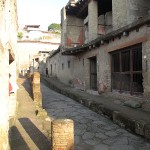
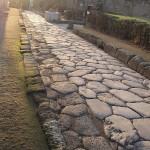
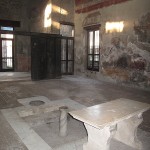
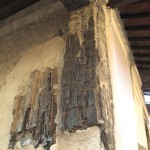
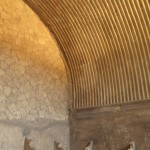
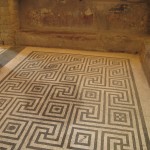
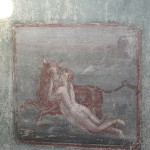
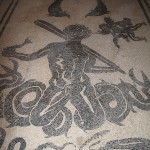
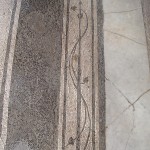
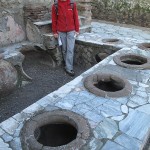
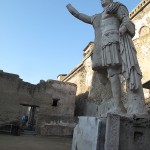
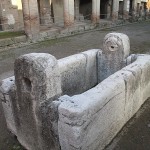
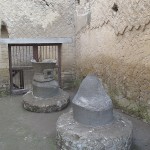
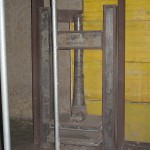
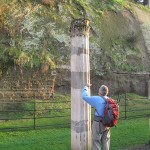
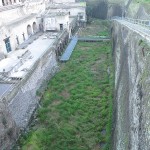
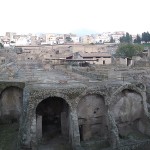
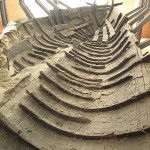
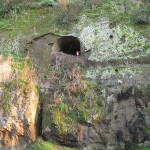
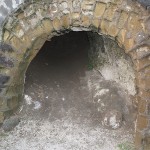





While nearly everyone has heard of the horrible tragedy of Pompeii, (If you haven’t, read our last blog.),… http://t.co/jMljqafnfb